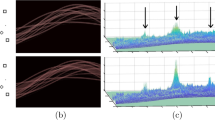Abstract
In this paper we present an algorithm to obtain a line representation of elongated figures whose main purpose is that of avoiding the distortions introduced by thinning algorithms. This is accomplished by using the information carried by the contour of the ribbons to detect the presence of regions where two ribbons merge or cross, since the distortions mainly affect the lines in correspondence of these regions. Once such a region is detected, the grassfire propagation model used to compute the spine is abandoned and shape preserving criteria are adopted to compute the line within the region. Experimental results show that the lines provided by the algorithm are not affected by the distortions typically present in the lines provided by thinning algorithms. They also show that the algorithm provides a line representation of the figures that can be immediately used to obtain the decomposition of the figure into pieces, each one corresponding to one of the ribbon making up the figure, which is highly desirable in many applications dealing with ribbon like figures.
Preview
Unable to display preview. Download preview PDF.
Similar content being viewed by others
References
L. Lam, S.W. Lee and C.Y. Suen, “Thinning methodologies — A comprehensive survey”, IEEE Trans. on Patt. Anal and Mach. Intell., vol. PAMI-14, no.9, 1992, pp.869–887.
L.P. Cordella and A. Marcelli, “An alternative approach to the performance evaluation of thinning algorithms for document processing applications”, Proc. Int. Workshop on Graphic Recognition, University Campus, PA (USA), August 10–11, 1995.
H. Blum, “A transformation for extracting new descriptors of shape”, in: Models for the Perception of Speech and Visual Form, (W. Watjen-Dunn, ed.), MIT Press, Cambridge:MA, 1967, pp.362–380.
A. Sirjani and G.R. Cross, “On representation of a shape's skeleton”, Pattern Recognition Letters, vol.12, 1991, pp.149–154.
S.W. Lu and H. Xu, “False stroke detection and elimination for character recognition”, Pattern Recognition Letters, vol.13, 1992, pp.745–755.
G. Boccignone, A. Chianese, L.P. Cordella and A. Marcelli, “Using skeletons for OCR”, in: Progress in Image Analysis and Processing, (V.Cantoni et al eds.), World Scientific Publishing Co., Singapore, 1990, pp.275–282.
V.K.Govindan and A.P. Shivaprasad, “A pattern adaptive thinning algorithm”, Pattern Recognition, vol.20, no.6, 1987, pp.623–637.
R.M. Brown, T.H. Fay and C.L. Walker, “Handprinted recognition system”, Pattern Recognition, vol.21, no.2, 1988, pp.91–118.
X. Li and A. Basu, “Variable-resolution character thinning”, Pattern Recognition Letters, vol.12, 1991, pp.241–248.
G. Borgefors, “Distance transformations in digital images”, CVGIP, 34, 1986, pp.344–371.
U. Montanari, “Continuous skeletons from digitized images”, Journal of ACM, vol. 16, 1969, pp.534–549.
M. Frucci and A. Marcelli, “Efficient skeletonization of binary figures through (d1,d2)-erosion and directional information”, in: Aspects of Visual Form Processing, (C. Arcelli et al. eds.), World Scientific, Singapore, 1994, pp. 221–230.
M. Frucci and A. Marcelli, “Parallel skeletonization by directional information”, Proc. ICIP-94, Austin, TX (USA), November 13–16, 1994, pp.681–685.
Author information
Authors and Affiliations
Editor information
Rights and permissions
Copyright information
© 1995 Springer-Verlag Berlin Heidelberg
About this paper
Cite this paper
Frucci, M., Marcelli, A. (1995). Line representation of elongated shapes. In: Hlaváč, V., Šára, R. (eds) Computer Analysis of Images and Patterns. CAIP 1995. Lecture Notes in Computer Science, vol 970. Springer, Berlin, Heidelberg. https://doi.org/10.1007/3-540-60268-2_358
Download citation
DOI: https://doi.org/10.1007/3-540-60268-2_358
Published:
Publisher Name: Springer, Berlin, Heidelberg
Print ISBN: 978-3-540-60268-2
Online ISBN: 978-3-540-44781-8
eBook Packages: Springer Book Archive




